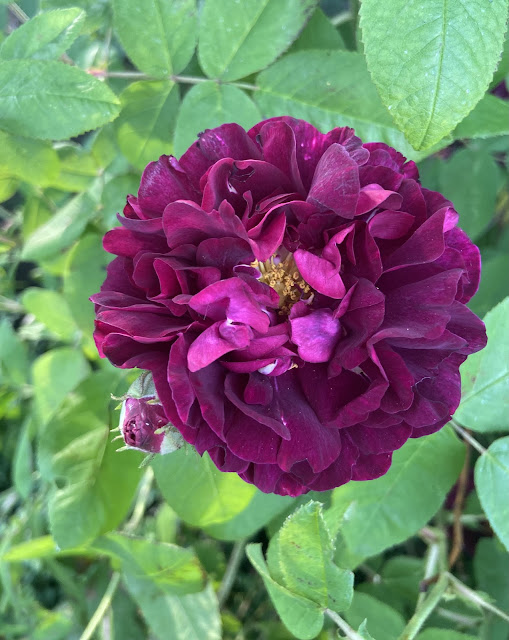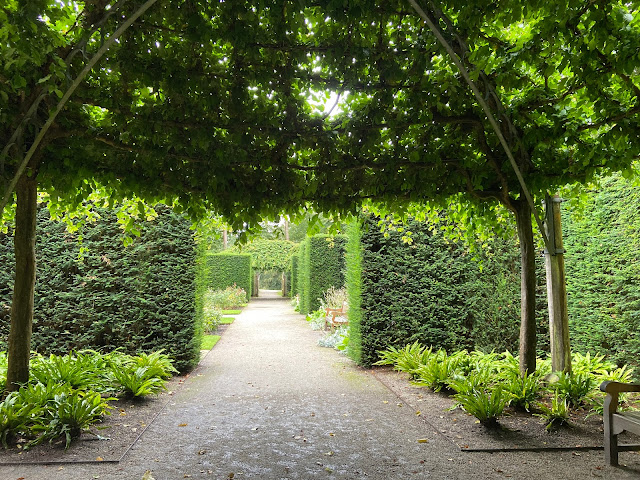A DISCOURSE ON THE OLD ROSES
Usually I will only bother you with one post a week, but my attempt to write about all the roses in the garden would make that weekly post far too unwieldy, so here is another mid week post which you may read or ignore as takes your fancy. In this one I've grouped together all the so called old roses as they were of great interest to me when I began to plan the Rose Garden about 12 years ago.
The idea of growing the old roses has a very romantic appeal. A little of the glamour of Josephine Bonapart's rose garden at Malmaison could be yours. Or perhaps your dreams are of an Edwardian country house with roses climbing the walls? But which ones should you grow? There are so many with their numerous different groupings - Bourbons, Gallicas, Albas, Hybrid Musks and so on. Trying to navigate all these various types is enough to make your head spin.
I'm not an expert by any means, but below you will find what I've learnt and what I grow. I'm indebted to 'An English Rose Garden' by Graham Stuart Thomas for the information on the history of these roses. I've tried to keep this simple.
It all started with Rosa gallica, a single pink rose, native to the South of France and further East. It has a cousin, Rosa Damascena, (the Summer Damask) which is grown in the Middle East and India for rose water and rose extracts.
 |
| Above and below - Mme. Hardy - Damask Rose 1832 |
Rosa gallica was able to be crossed with the Dog Brier, Rosa canina, to produce a group of Alba roses aka the old White Roses (of which some are pink!).
Now the Alba roses are a favourite of mine as black spot and other foliage problems trouble them not, and they are happy in a partly shady spot. These are the ones I grow:-
Let us start with Cuisse de Nymph or Maiden's Blush as it seems to be called in these more enlightened times. I grow this for its historical associations and it is rather lax in its habit. I may give it a better location (with some sun!) and see if it grows a little stronger.
 |
| Above and below - Maiden's Blush - Alba 1400 |
Next is my favourite of the Albas.
 |
| Above and below - Queen of Denmark - Alba rose 1816 |
 |
| Above and below - Rosa 'Felicite Parmentier, Alba 1834 |
 |
| Above and below - Rosa 'Celestial '- Alba Rose pre 1810 |

 |
| Chloris - Alba rose 1820 in centre back of photo |
Now returning to our history of roses and another introduction to the cross breeding - R. moschata, the Musk rose which flowers in late summer. A useful trait to extend the flowering season. The resulting hybrids with Rosa gallica were called Autumn Damasks.
Various natural or intended hybrids were created so that by 1620 in Holland the Cabbage Rose (R.x centifolia) with deep many petaled scented blooms was introduced.
Further development led to the Moss Rose, that curiosity beloved of the Victorians which has moss like stalks and calyx. I had to have a representative of this group and I chose William Lobb.
 |
| Above and below - Rosa 'William Lobb' Moss Rose, 1855 |
Nurserymen, mainly French, took all these roses - the Summer Damask, the Albas, Autumn Damasks, Cabbage Roses and Moss Roses and interbred them to produce new varieties.
 |
| Above and below - Cardinal de Richelieu - Gallica 1840 |
 |
| Tuscany Superb - Gallica 1848 |
Tuscany Superb is really very Superb and a wonderful colour.
By this stage it becomes difficult even for the experts to determine exactly which roses are the offspring of which parents, although it is thought that Rosa Gallica crossed with the Autumn Damask produced the Portland Rose, which in an important new development, can repeat flower.. These were named after the Duchess of Portland who was among the first to grow these.
I grow two roses from this group. They are both more compact shrubs than the varieties above with this lighter, matt, apple green foliage. Their blooms are many petaled and flat rather than cupped. I would recommend them.
 |
| Above and below - Rose de Rescht - Portland Rose 1880 |
 |
| Above and below - Comte de Chambord - Portland Rose 1860 |
So far all the roses have been in the white, pink, purple colour range. Now comes Rosa chinensis, the China Rose, to add to the gene pool. Now they flower continuously until the Autumn and have coppery or yellowish tints in addition to pink. Crossing a yellow Chinese rose with the European roses above let to the old Noisette and Tea climbers such as 'Gloire de Dijon' and 'Alister Stella Gray'. I've just planted the later this spring and no flowers to show you yet.
Crossing a pink Chinese rose with the European ones gave us the Bourbon roses.
 |
| Above and below - Prince Charles - Bourbon Rose 1842 |
Further developments led to the roses known as 'Hybrid Perpetuals'.
Firstly may I say this rose hasn't repeat flowered for me, but nevertheless I'm assured it is a Hybrid Perpetual. It's lovely anyway to I will forgive it.
 |
| Above and Below - Reine Des Violettes - Hybrid Perpetual 1860 |
And that wraps up this post of the old roses. If you want roses that will furnish your garden with colour over a long season then these are not for you (and there are plenty of lovely roses that will so don't be disheartened), but if you like to use old china and wear vintage jewellery, if you would rather live in a old cold house than a warm modern one, if you place romantic notions over practicalities then perhaps the old roses might be for you.












Comments
Post a Comment